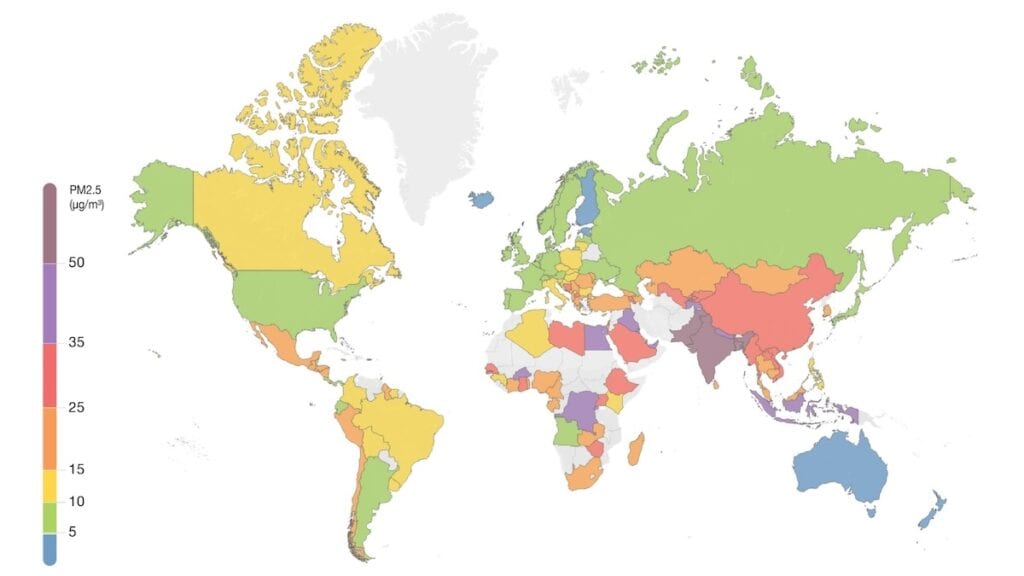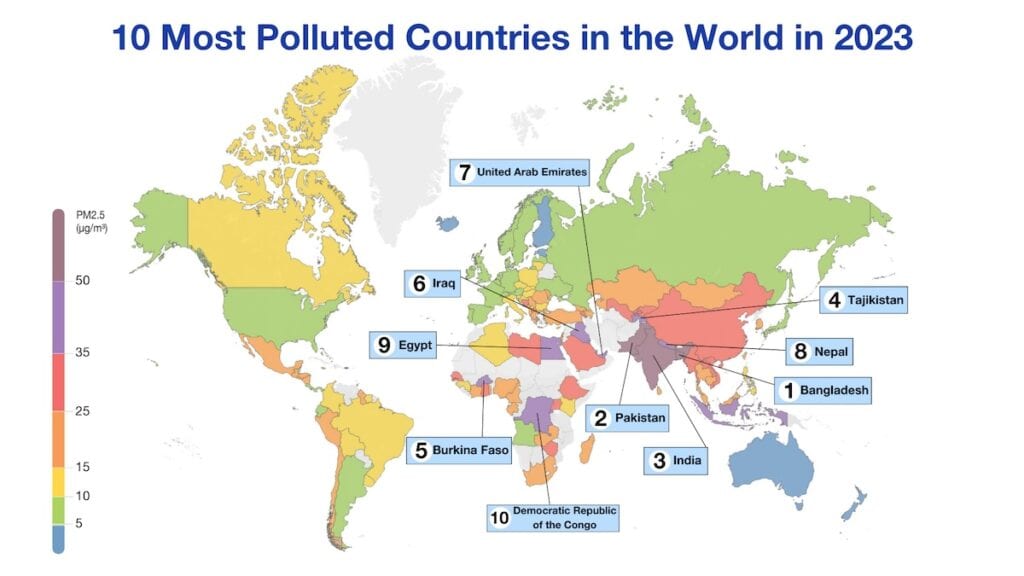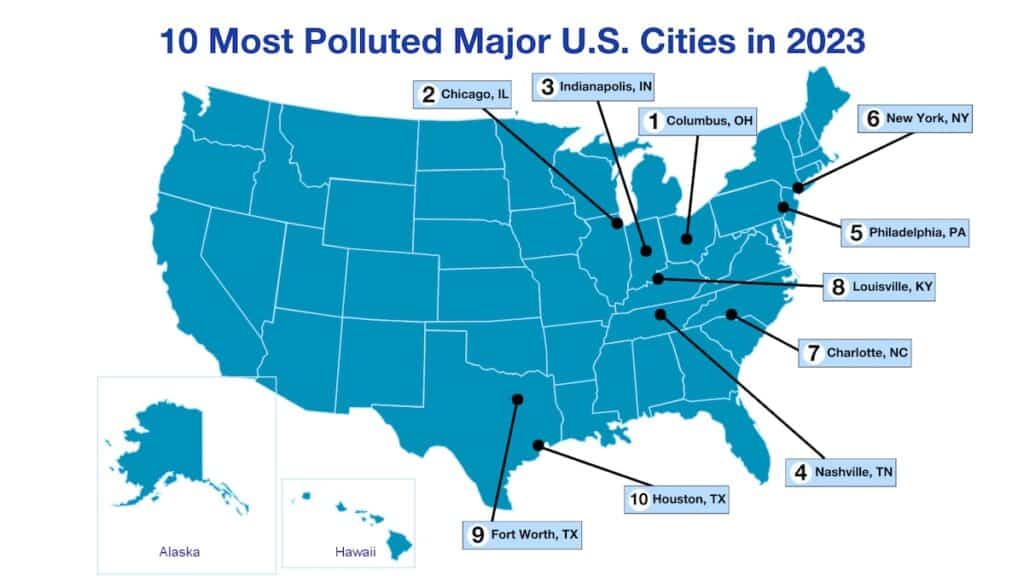
The world’s most comprehensive data-based report into global air quality reveals only seven countries currently meet recognised health standards, exposing pollution hotspots and environmental inequality.
Published by Swiss tech specialists IQAir, the 2023 World Air Quality Report employs extensive data collection to reveal troubling details of the world’s most polluted countries, territories, and regions in 2023.
For this year’s annual report, scientists at IQAir crunched data from more than 30,000 air quality monitoring stations across 7,812 locations in 134 countries, territories, and regions.
After 2022, when a surge in pollution marked the reopening of many economies worldwide post-pandemic, this new data presents a more nuanced and varied narrative.
The 2023 numbers highlight both positive developments and emerging concerns.
Overall, the bad news is that, out of the 134 countries and regions analysed, as many as 124 (92.5%) exceeded the WHO annual PM2.5 guideline value of 5µg/m3. Only seven countries successfully met the target: Australia, Estonia, Finland, Grenada, Iceland, Mauritius, and New Zealand.
Particulate matter (PM) refers to the mixture of solid particles and liquid droplets in the air, either human-made or naturally occurring. As PM varies in size, PM2.5 is used as a measure of particles with a size generally less than 2.5 micrometres in diameter. This is also known as fine particulate matter.
Pollution hotspots — Bangladesh and cities in India

At the wrong end of the scale, the five most polluted countries in 2023 were:
- Bangladesh (79.9µg/m3) — more than 15 times higher than the WHO PM2.5 annual guideline;
- Pakistan (73.7µg/m3) — more than 14 times higher;
- India (54.4µg/m3) — more than 10 times higher;
- Tajikistan (49.0µg/m3) — more than 9 times higher; and
- Burkina Faso (46.6µg/m3) more than 9 times higher than the guideline.
India was home to the four most polluted cities in the world, with Begusarai the worst metropolitan area.
The top 10 most polluted cities were to be found in Central & South Asia.
Climate conditions and transboundary haze were also major factors in Southeast Asia, where PM2.5 concentrations rose in nearly every country.
North America — from Canada, to Columbus

For the first time in the history of the report, Canada was the most polluted country in Northern America, with the region’s 13 most polluted cities located within its borders.
As for the US, Las Vegas, in Nevada, was actually the cleanest major city. The most polluted major city was Columbus, Ohio, whereas Beloit, Wisconsin, was the most polluted city, regardless of size.
Europe — Croatia better, Montenegro worse
In the 2023 findings, Europe is represented by 2,006 cities across 43 countries.
The good news is that the continent shows a downward trend, overall. In total, PM2.5 levels fell for 36 countries across Europe, increased for just six, and remained constant for one.
More cities fell within the green range (1 to 2 times the WHO guideline) this year, compared to 2022.
Nevertheless, only 7% of cities in Europe actually met the PM2.5 guideline. The UK has the highest number of guideline-compliant cities, followed by Finland and Sweden.
Despite a slight increase in PM2.5 levels, Iceland remains the least polluted country in the region with an average of 4µg/m3. Croatia made significant progress, though, lowering PM2.5 levels by more than 40%.
At the other end of the European rankings, Bosnia Herzegovina remains the most polluted country, with an annual average concentration of 27.5µg/m3, although it did see an 18% decrease in PM2.5 levels. Going in the wrong direction, Montenegro experienced the greatest absolute increase in PM2.5 concentrations.
On a positive note for monitoring, government-operated stations contribute 73% of air quality data in Europe, with Germany having the highest number of cities included in the report. Russia’s data has been bolstered by contributions from non-government operated stations.
Global gaps in the monitoring map
While the number of countries and regions with air quality monitoring has steadily increased over the past six years of reporting, significant global gaps remain in government-operated regulatory instrumentation.
Africa is the most underrepresented continent, with a third of the population still lacking access to data.
Nevertheless, in many parts of the world, society is rising to the reporting challenge.
Low-cost air quality monitors, sponsored and hosted by citizen scientists, researchers, community advocates, and local organisations, are proving valuable tools for reducing gaps in air monitoring networks. Some 70% of real-time air quality data in Latin America & Caribbean now comes from low-cost sensors.
These independent air quality monitoring stations reveal disproportional exposure to harmful air pollution among vulnerable and underrepresented groups. Glaring gaps in air quality monitoring data, where pollution is likely poor, further underline the need to expand air quality monitoring coverage worldwide.
Access to data ultimately underpins clean air action, states Frank Hammes, Global CEO, IQAir:
“The lack of air quality data delays decisive action and perpetuates unnecessary human suffering. Where air quality is reported, action is taken, and air quality improves. Air quality data saves lives.”
The issue is international, says Dr Aidan Farrow, Senior Air Quality Scientist, Greenpeace International:
“In 2023 air pollution remained a global health catastrophe, IQAir’s global data set provides an important reminder of the resulting injustices and the need to implement the many solutions that exist to this problem.
“Local, national, and international effort is urgently needed to monitor air quality in under-resourced places, manage the causes of transboundary haze, and cut our reliance on combustion as an energy source.“
IQAir is a Swiss technology company that empowers individuals, organisations and governments to improve air quality through information, collaboration, and intervention.
Further Reading:
- More about IQAir; and the 2023 World Air Quality Report, complete with interactive map.
- More about the WHO global air quality guidelines for particulate matter (PM2.5 and PM10);
- Also on SustMeme, Ultra-early wildfire detection raises pilot-site alarm;
- Also on SustMeme, Recovered carbon black could cut emissions 93%;
- Also on SustMeme, Pay-per-mile tyre to cut pollution from EV taxis;
- Also on SustMeme, Landlord pioneers use of antiviral air-purifying paint.;
- Also on SustMeme, Sustainability + Justice = SUSTICE.
Check out the full archive of stories on the SustMeme Climate & Energy Channel, now available to Sponsor.


